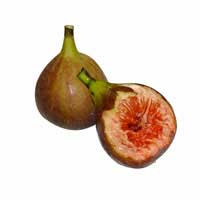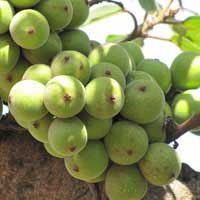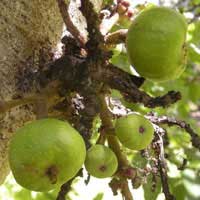 Full List of Fruits
Full List of Fruits  Cluster Fig Fruit
Cluster Fig FruitCluster Fig Fruit
![]() Introduction of Cluster Fig Fruit
Introduction of Cluster Fig Fruit
Scientific name - Ficus racemosa
Cluster fig scientifically known as Ficusracemosa belongs to the Moraceae family. This tree is considered sacred in India and is popularly known as Indian fig tree or Gular tree. It has its native rooted in the regions of Australia, Malaysia, South East Asia and India. This tree has made its prominence felt in medicinal books propagating Ayurveda. These figs generally grow in clusters measuring about 10-35m long.
The fig fruits serve as an important vitamin supplements and also considered as a traditional medicine as it contains laxative substances, sugars, vitamins A and C, acids and enzymes. In Athrva Veda the fig tree is mentioned as a symbolic representation of acquiring prosperity and vanquishing woes. The leaves of the fig tree are an important component of many hinduhavans and rituals.
This tree is normally found growing t o a height of 15 to 18 meters tall along the sides of streams or rivers.
![]() Nutritional Value of Cluster Fig Fruit
Nutritional Value of Cluster Fig Fruit
| Moisture content | 80.20% |
| Crude Fibre | 0.50% |
| Total carbohydrate | 15.84 gm |
| Calcium | 30.5 mg |
| Iron | 315 mg |
| Sodium | 329 mg |
| Potassium | 49.3 mg |
| Protein | 28.12 mg |
| Fat | 1 mg |
| Mineral | 2 mg |
| Carotene | 200 mg |
| Ascorbic acid | 5.3 mg |
| Phosphorus | 103 mg |
![]() Health benefits of Cluster Fig Fruit
Health benefits of Cluster Fig Fruit
Cluster fig is a power house of health benefits and is known for its medicinal properties. . The phytochemicals present in the plant constitutes as the bioactive substance that is the catalyst in prevention of diseases and also aids in curing them. The trend of using herbs and plant properties for its medicinal value dates back to medieval period. Different plants have different phytochemicals below mentioned are the diseases and its cure by cluster fig.
 Mouth ulcers and oral infections can be cured by consuming the bark of cluster fig cooked in water for a few minutes and filtered before consumption. This should be used as a substitute to the normal water based mouth washes.
Mouth ulcers and oral infections can be cured by consuming the bark of cluster fig cooked in water for a few minutes and filtered before consumption. This should be used as a substitute to the normal water based mouth washes.
 Menorrhagia is a condition faced by women during their menstrual cycle. Excessive bleeding faced by women during those days can cause a lot of blood loss. This occurs mainly due to ovarian cyst and also hormonal imbalance. The consumption of dried figs with honey is a remedial measure to control the excessive bleeding to an extent and bring balance in the body.
Menorrhagia is a condition faced by women during their menstrual cycle. Excessive bleeding faced by women during those days can cause a lot of blood loss. This occurs mainly due to ovarian cyst and also hormonal imbalance. The consumption of dried figs with honey is a remedial measure to control the excessive bleeding to an extent and bring balance in the body.
 Grinding the bark of the gular tree with some water on a stone; the paste of which can be applied on swollen areas that will help in reducing the swell in affected areas.
Grinding the bark of the gular tree with some water on a stone; the paste of which can be applied on swollen areas that will help in reducing the swell in affected areas.
 Beauty conscious or not no one likes a face with freckles and pimples, cluster fig tree bark can come to rescue. The inner side of the bark should be made into a paste and applied on the affected areas to reduce the number of pimples and freckles. This remedy can also be used to treat boils.
Beauty conscious or not no one likes a face with freckles and pimples, cluster fig tree bark can come to rescue. The inner side of the bark should be made into a paste and applied on the affected areas to reduce the number of pimples and freckles. This remedy can also be used to treat boils.
 Burns often leave a scared body, burn marks that are hard to rectify can be treated by applying a paste of the cluster fig. the application of cluster fig with honey will help one retain the normal skin tone , if applied religiously. The tightening and stiffness of the plant can also be reduced by application of bark and leaves of the cluster fig on burnt areas.
Burns often leave a scared body, burn marks that are hard to rectify can be treated by applying a paste of the cluster fig. the application of cluster fig with honey will help one retain the normal skin tone , if applied religiously. The tightening and stiffness of the plant can also be reduced by application of bark and leaves of the cluster fig on burnt areas.
 Piles and fistula can be treated by applying the latex of gular tree after plucking leaves. A cotton should be soaked in the latex and is to be applied on affected areas.
Piles and fistula can be treated by applying the latex of gular tree after plucking leaves. A cotton should be soaked in the latex and is to be applied on affected areas.
 10-15 ml of gularuice consumption can help in curing dysentery
10-15 ml of gularuice consumption can help in curing dysentery
 Latex derived of out leaves of gular tree are used as a medicine for cuts and muscle pain
Latex derived of out leaves of gular tree are used as a medicine for cuts and muscle pain
 Cluster fig consumed with ingredients such as rock salt and ajwain can help treat stomach aches
Cluster fig consumed with ingredients such as rock salt and ajwain can help treat stomach aches
 People who complaint about cracked heels should apply latex on their heels for smoother and supple skin on their feet.
People who complaint about cracked heels should apply latex on their heels for smoother and supple skin on their feet.
Cluster fig are fast growing trees with aggressive rooting system. These trees not just proved us with the fruit but also provides shade to the animals and birds along the river course. This tree is cannot be found in commercial areas and never near sewer lines or drainage areas as it might damage the road or uproot it due to its ever continuously growing root system. Owing to its popularity with birds and insects the broom cluster fig is the ideal tree for the wildlife garden.
When the figs are ripe it is resonant of a bird-feeding table as all nature of fruit-eating creatures come together to obtain their share of the sweet reward produced by the tree.
This tree is popular amongst the fruit bats who are particularly fond of the figs. Some insectivorous birds such as the Puffback shrike apparently take the fruit for their consumption. It is not just the fruits, Elephants also sometimes eat the leaves and twigs of the tree.
Cluster fig can be propogated by the the method of germination of the seed. The seed is obtained by cleaning it away from the fruity part of the fig, this can then be sown on a fine medium bed of soil but precaution to be taken that it should not be covered. One can spot the seed germinating quickly and seedlings can be transplanted once they are a few centimetres high.
In case of mature trees of considerable size, they have been transplanted with success, although large trees inevitably have to be severely pruned to facilitate transplanting, often scarring them for life. Thus in such cases it is probably better to plant young trees, which will grow fast and make more beautiful, mature specimens. This plant thrives best in conditions where there is abundance in sunlight and water.



















